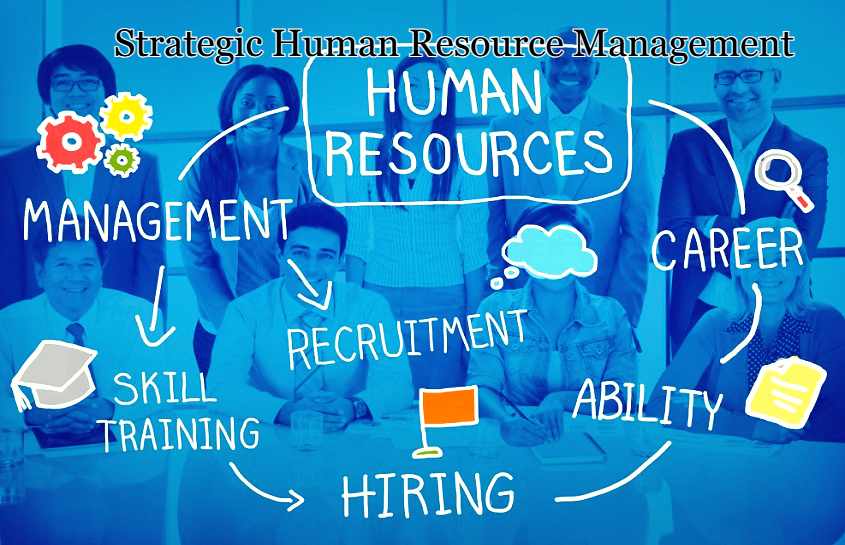In today’s competitive business world, the job is not just about hiring employees. In modern organizations, human resource management has also become part of the business strategy. That is why the concept of Strategic Human Resource Management (SHRM) has come to the fore.
In this article, we will know what SHRM actually is, why it is important, which models are used more often, and how organizations are implementing it successfully in practice.
What is Strategic Human Resource Management?
Strategic Human Resource Management means a process where employees are linked to the long-term goals and plans of the organization. It is not limited to just hiring, training or determining salaries — rather, it is a strategy to shape the future success of the organization through employees.
Example:
Suppose a company wants to lead the market in artificial intelligence (AI). In this situation, SHRM will ensure that the organization is adding talent with AI-related skills, getting trained and helping the organization achieve its goals.
Why is SHRM important?
An organization that is only busy solving current problems is not preparing for the future. And that is where the importance of Strategic HRM comes in. SHRM actually develops human resources keeping the future in mind. This approach is now the need of the hour to keep pace with the skills of employees, organizational goals and changing times.
- Matching goals and plans: SHRM ensures that the HR department is actively involved in implementing the goals set by the organization.
- Talent management becomes easier: Not just hiring people for work, but also creating future leadership, improving skills — all this is possible with SHRM.
- Long-term results: The organization benefits by retaining employees, improving skills, and building a structure according to the plan.
- Employee involvement increases: When HR works strategically, employees also work as if they are the organization — resulting in better results.
Main features of SHRM
Let’s take a closer look at the main features that define this modern approach to people management.
- Future-oriented thinking
- Data and analysis-based decisions
- Directly related to business strategy
- Able to adapt to change
- Preparations are made before problems occur
Some popular models of SHRM

Every organization is run by people, but their management methods are not the same. Sometimes, even though the goal is the same, the management differs. This is where the various models of SHRM give us guidance. These models help us adapt to the capabilities of people, the needs of the organization, and the times. Let’s see how some important models help in this work.
- Harvard Model: This model emphasizes employee participation, human resource flow, reward system, and work style.
- Michigan Model: This model states that HR strategy should always be aligned with business strategy. It emphasizes four areas—selection, performance, appraisal, and reward.
- Guest Model: This model emphasizes high-quality workforce development, commitment, flexibility, and efficiency. It makes SHRM practical.
SHRM vs. Traditional HRM
On one hand, there is traditional human resource management, which usually revolves around day-to-day operations. On the other hand, strategic HRM (SHRM) plans with the future goals of the organization in mind. The table below highlights the main differences between the two.
| Traditional HRM | Strategic HRM |
| Solves problems after they occur | Prepares in advance to prevent problems |
| Operates separately from business strategy | Aligned with the organization’s strategic goals |
| Plans recruitment for short-term needs | Builds workforce with future goals in mind |
| Focuses on paperwork and rules | Driven by results, skills, and strategy |
How does SHRM work in practice?
SHRM actually works when human resource management is aligned with organizational goals and decisions.
- Google: Google creates an innovative environment by giving their employees freedom, development, and training — which aligns with their business strategy.
- Walmart: Walmart emphasizes skills and adopts a method of training and managing employees that helps them ensure more services at lower costs.
- Startups: Many startups offer employees shares or stock options, so they feel involved in the success of the organization.
How do you implement SHRM?
To implement SHRM in practice, human resource policies need to be aligned with the organization’s long-term strategy
Set business goals
First, know what you want to achieve.
- Involve the HR team in strategy setting
Not just work — involve the HR department from the planning stage.
Analyze skills
Determine what skills your employees have and need — and what they need.
Create HR policies
Create realistic plans for hiring, training, rewarding, and retaining employees.
Measure and improve results
Understand what worked and what didn’t — and take the next step.
Conclusion
Strategic Human Resource Management is not a separate function — it’s about making HR part of the business. When you can shape your workforce to meet your future goals, your organization is on the path to success.
If you haven’t thought about HR strategically yet, start today — because a strong HR plan is always the foundation of a successful organization.
FAQs
A: There are three levels.
1. Corporate level
2. Business level
3. Functional level
A: Yes, in fact, if small organizations use HR strategically from the beginning, they will have a lot of advantages as they grow.
A: Of course. SHRM makes it easy to manage remote employees, set goals, and review results.
